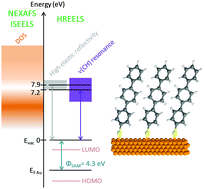DOS and electron attachment effects in the electron-induced vibrational excitation of terphenylthiol SAMs
Abstract
Low energy electron scattering on terphenylthiol (TPT, HS-(C6H4)2-C6H5) self-assembled monolayers (SAMs) deposited onto gold was investigated using high resolution electron energy loss spectroscopy (HREELS) by recording specular elastic and inelastic excitation functions. The electron elastic reflectivity could be directly compared to the sample density-of-states (DOS) above vacuum level. A high reflectivity region was observed in the range 7.2–8.6 eV. Inelastic excitation functions were studied to get insights into the mechanisms involved in the excitation of a selection of vibrational modes (dipolar and impact scattering). In particular, a resonant mechanism was observed in the excitation of the stretching mode ν(CC) at 196 meV. The purely resonant contribution to the electron-induced excitation of the stretching modes ν(CH) (379 meV) could be extracted from the overtone excitation. It is located at 7.2 eV above the vacuum level and is characterized by a width of 3.4 eV.


 Please wait while we load your content...
Please wait while we load your content...